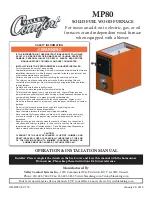
N92ESN: Installation, Start-up, Operating and Service and Maintenance Instructions
Manufacturer reserves the right to change, at any time, specifications and designs without notice and without obligations.
60
10. Turn power on at external disconnect, fuse or circuit breaker.
11. Run the furnace through two complete heating cycles to check for
proper operation
12. Install control door when complete.
Checking Heat Pad Operation (If Applicable)
In applications where the ambient temperature around the furnace is
32
_
F or lower, freeze protection measures are required. If this
application is where heat tape has been applied, check to ensure it will
operate when low temperatures are present.
NOTE:
The Heat Pad, when used, should be wrapped around the
condensate drain trap. There is no need to use heat tape within the
furnace casing. Most heat tapes are temperature activated, and it is not
practical to verify the actual heating of the tape. Check the following:
1. Check for signs of physical damage to heat tape such as nicks, cuts,
abrasions, gnawing by animals, etc.
2. Check for discolored heat tape insulation. If any damage or
discolored insulation is evident, replace heat tape.
3. Check that heat tape power supply circuit is on.
Cleaning Heat Exchangers
The following items must be performed by a qualified service
technician.
Primary Heat Exchangers
If the heat exchangers get an accumulation of light dirt or dust on the
inside, they may be cleaned by the following procedure:
NOTE:
If the heat exchangers get a heavy accumulation of soot and
carbon, both the primary and secondary heat exchangers should be
replaced rather than trying to clean them thoroughly due to their intricate
design. A build-up of soot and carbon indicates that a problem exists
which needs to be corrected, such as improper adjustment of manifold
pressure, insufficient or poor quality combustion air, improper vent
termination, incorrect size or damaged manifold orifice(s), improper gas,
or a restricted heat exchanger (primary or secondary). Action must be
taken to correct the problem.
1. Turn off gas and electrical supplies to furnace.
2. Remove control door.
3. Disconnect wires or connectors to flame rollout switch, gas valve,
igniter, and flame sensor.
4. Using backup wrench, disconnect gas supply pipe from furnace gas
control valve.
5. Remove two screws attaching top filler plate and rotate upwards to
gain access to screws attaching burner assembly to cell panel.
6. Remove screws attaching burner assembly to cell panel. See
NOTE:
Burner cover, manifold, gas valve, and burner assembly should
be removed as one assembly.
7. Clean heat exchanger openings with a vacuum and a soft brush. See
A11273
Fig. 69 – Cleaning Heat Exchanger Cell
NOTE:
After cleaning, inspect the heat exchangers to ensure they are
free of all foreign objects that may restrict flow of combustion products.
8. Reverse items 6 through 1 for reassembly.
9. Refer to furnace wiring diagram and reconnect wires to flame
rollout switch, gas valve, igniter, and flame sensor.
10. Turn on gas and electrical supplies to furnace.
11. Check furnace operation through 2 complete heat operating cycles.
Look at burners. Burner flames should be clear blue, almost
transparent. See
.
12. Check for gas leaks.
13. Replace main furnace door.
Secondary Heat Exchangers
The condensing side (inside) of the secondary heat exchanger CANNOT
be serviced or inspected without complete removal of the heat exchanger
assembly. Detailed information on heat exchanger removal can be
obtained from your Distributor.
WARNING
!
ELECTRICAL SHOCK, FIRE OR EXPLOSION HAZARD
Failure to follow this warning could result in personal injury or death,
or property damage.
Before installing, modifying, or servicing system, main electrical
disconnect switch must be in the OFF position and install a lockout tag.
There may be more than one disconnect switch. Lock out and tag
switch with a suitable warning label. Verify proper operation after
servicing. Always reinstall access doors after completing service and
maintenance.
WARNING
!
FIRE OR EXPLOSION HAZARD
Failure to follow this warning could result in personal injury, death,
and/or property damage.
Never purge a gas line into a combustion chamber. Never test for gas
leaks with an open flame. Use a commercially available soap solution
made specifically for the detection of leaks to check all connections. A
fire or explosion may result causing property damage, personal injury
or loss of life.
WARNING
!
ELECTRICAL SHOCK AND FIRE HAZARD
Failure to follow this warning could result in personal injury, death,
and/or property damage.
Turn off the gas and electrical supplies to the furnace and install lockout
tag before performing any maintenance or service. Follow the operating
instructions on the label attached to the furnace.







































